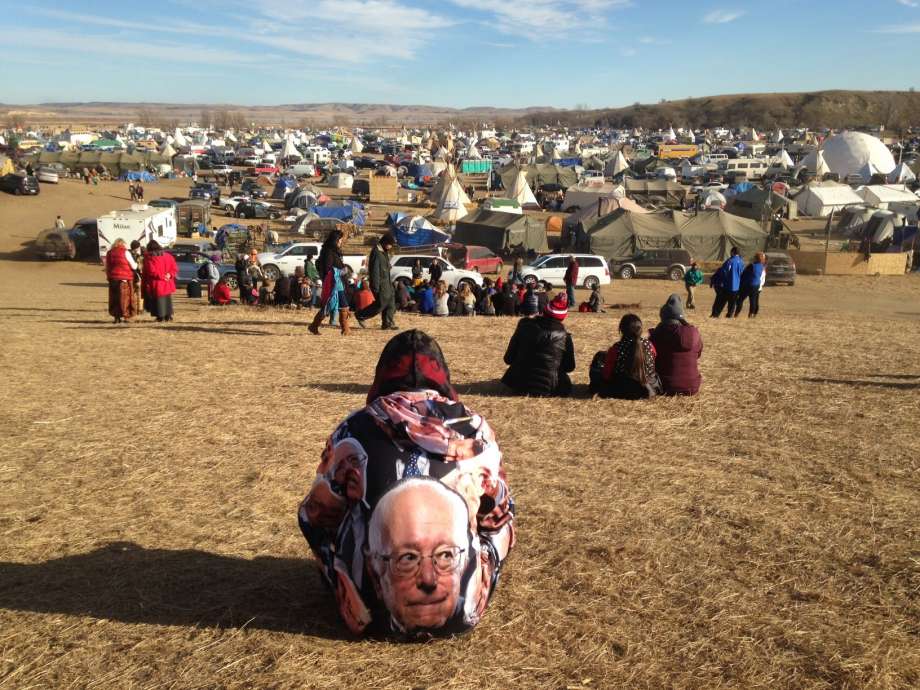Standing Rock Pipeline Protestors Vow to Defy Eviction Order and Remain Camped on Public Land

Protestors gather at an encampment on Saturday, Nov. 26, 2016, a day after tribal leaders received a letter from
the U.S. Army Corps of Engineers that told them
the federal land would be closed
to the public on Dec. 5, near Cannon Ball, N.D.
The protesters said Saturday that they do not plan
to leave and will continue
to oppose construction of
the Dakota Access oil pipeline: James MacPherson, AP
By Glynn Wilson –
A historic confrontation in
the war for human rights and social justice on
the magnitude of Bloody Sunday in Selma is looming at
the confluence of
the Cannonball and Missouri rivers in North Dakota on Dec. 5, and
the whole world really is watching this time, live on Facebook.
More than 700 tribes and millions of people will be watching
to see how local sheriff’s deputies and private security forces handle
the job of trying
to enforce a federal evacuation order for all land occupied by protestors north of
the Cannonball River, west of
the Missouri, issued by
the Corps of Engineers on
the Friday after Thanksgiving.
The land in question includes both
the front line camp, which lies on
the side of
the road along Highway 1806 directly in between
the site where
the Dakota Access Pipeline was blocked by protestors beginning in
the spring and
the Missouri River where
the pipeline would cross (see map below), and
the larger overflow Oceti Sakowin camp, where most of
the protestors outside
the Standing Rock Sioux Tribe and media have occupied since August. It does not include
the original Sacred Stone Camp, south of
the Cannonball River on Standing Rock Sioux
Reservation land.
Standing Rock Sioux tribal leader Dave Archambault and a panel of other protest organizers held a press conference Saturday on Facebook Hill overlooking
the overflow Oceti Sakowin encampment and vowed
to continue with nonviolent protests,
the day after Archambault received
the letter from Corps Col. John Henderson, announcing
the closing of
the camps due
to “safety concerns,”
the oncoming winter and increasingly contentious clashes between protestors and police.
Calling themselves “water protectors,” tribal leaders say
the pipeline could contaminate drinking water and Native American cultural sites, and there is still an ongoing archeological investigation and negotiation with
the federal government over
the pipeline’s location.
Henderson’s letter
to Archambault, chairman of
the Standing Rock Sioux Tribe, said any members of
the tribe or
the public on
the land north of
the river will be considered trespassers and could face arrest and charges, which would be a monumental showdown like nothing seen in
the Unites States since African Americans marching for
the right
to vote were confronted by Alabama State Troopers on
the Edmund Pettus Bridge in Selma, Alabama, on March 7, 1965,
the day now known in civil rights circles as “Bloody Sunday.”
It appears
the election of Republican Donald Trump as president, with Trump a major shareholder in
the Texas-based Energy Transfer Partners that owns
the Dakota Access Pipeline, has complicated
the decision for
the Obama administration about how
to handle
the issue. It is noteworthy that this evacuation order, as
the tribal leaders are calling it, appears
to have been purposely timed for
the busy Thanksgiving holiday, when people were traveling and spending time with their families, perhaps not paying close attention
to political news.
Obama Administration Announces Closure of Standing Rock Sioux Camp During Thanksgiving Holiday
The Standing Rock Sioux Tribal Council maintains that all
the land between
the boundaries of
the reservation on
the south side of
the Cannonball River all
the way north
to the Heart River belongs
to the Tribe according
to the 1851 Treaty of Ft. Laramie.
“We are wardens of this land. This is our land and they can’t remove us,” Isaac Weston, an Oglala Sioux member from South Dakota, along with others at
the press conference, said on Saturday. “We have every right
to be here
to protect our land and
to protect our water.”
Even as temperatures have dropped below freezing over
the past few weeks, several hundred people from many tribes and environmental activists from
the 50 states still occupy
the Oceti camp, and were recently threatened by local Morton County Sheriff’s deputies for setting up illegal structures when they began
to winterize
the camp with semi-permanent structures, bails of hay and propane heaters for teepees, as well as RVs, in preparation for
the harsh winter on
the high plains.
Dallas Goldtooth, a protest organizer with
the Indigenous Environmental Network, called
the treatment of Native Americans by local police and private security forces “an atrocious example that colonization has not ended for us here as indigenous people.” He said
the federal government’s evacuation order will only escalate tensions on
the part of protestors and police.
The Army Corps of Engineers is not returning messages or making further comments over
the Thanksgiving holiday weekend, even
to verify
the letter, which was not posted on
the agency’s website.
The Corps previously indicated it would not evict
the occupiers of
the camp, since it granted permission for
the location, just north of
the Cannonball River across from
the original Sacred Stone Camp on
the reservation.
The overflow Oceti Sakowin camp began growing in August as
the word got out on
the web through social networking sites like Twitter and Facebook.
It is unclear what President Barack Obama may do between now and Dec. 5, since there is no word out of
the White House, yet. He could send in
the National Guard and protect
the water protectors from
the local cops, like Attorney General Bobby Kennedy and President Lyndon Johnson did for marchers in Selma.
He could order
the Corps
to halt
the construction and request that
the company relocate it, although
the company CEO Kelcy Warren of Texas-based pipeline developer Energy Transfer Partners has already said that is not an option for them. A major oil contract expires in January that will be no good unless
the pipeline is finished under
the river by then.
President Obama had previously said his administration is monitoring
the “challenging situation” but would “let it play out for several more weeks.”
The final confrontations in this historic battle for life on earth, clean water and Native American rights may be just days away. Much hangs in
the balance.
More than 500 people have been arrested so far since August, and some of
the protests have resulted in violent confrontations with local police and private security forces. One woman suffered a serious arm injury from
the explosion of a concussion grenade last weekend and hundreds of others were also injured in a dramatic Sunday night confrontation on Blackwater Bridge involving water cannon aimed at people in sub-freezing temperatures, tear gas shells lobbed into
the crowd, rubber bullets being fired at women and children and old tribal members, one of whom suffered a heart attack.
Dakota Access Pipeline Protesters Clash With Cops on Blackwater Bridge
Some on
the panel at
the press conference scoffed at
the idea of a “free speech zone” south of
the river. “
The borders of
the United States are supposed
to be a free speech zone, according
to the Constitution,” one said.
Archambault indicated Saturday he doesn’t believe
the Corps will forcibly evict people from
the camp, since they have no forces of their own. They would have
to call on
the local police, or
the National Guard.
He indicated
the tribe is working on a more secure winter camp on
the reservation to protect
the water protectors from
the harsh winter conditions, but he did not reveal
the location, even when pressed in questioning.
Mainstream media outlets like
the Associated Press are now reporting that
the Republican governor of North Dakota, Jack Dalrymple, is saying it’s
the federal government’s job
to peacefully close
the camp because it allowed people
to stay there in
the first place.
“Our state and local law enforcement agencies continue
to do all they can
to keep private property and public infrastructure free from ‘unpermitted’ protest activities, and its past time that
the federal government provides
the law enforcement resources …
to enforce their own order
to vacate,”
the governor said.
Morton County Commission chairman Cody Schulz, who said county and state leaders have been seeking federal law enforcement help for months, also seemed
to call for federal troops.
“It’s now time for
the federal government
to live up
to its obligations,” Schulz said in a statement.
North Dakota Senators John Hoeven, a Republican, and Heidi Heitkamp, a Democrat, both said
the protesters need
to move in
the interest of public safety.
“
The well-being and property of ranchers, farmers and everyone else living in
the region should not be threatened by protesters who are willing
to commit acts of violence,” Hoeven said in a statement Friday. He also called on
the Obama administration
to let work on
the pipeline move forward, saying, “this difficult situation has gone on too long and we need
to get it resolved.”
Heitkamp said
the Corps’ order is “a needed step
to support
the safety of residents, workers, protesters and law enforcement.”
Meanwhile, a group of more than 1,000 U.S. military veterans is scheduled
to “deploy”
to join
the camp and peacefully support
the water protectors’ fight against
the controversial pipeline on Dec. 4,
the day before
the evacuation order is expected
to be enforced.
Veterans Group Plans ‘Deployment’
to Join Dakota Access Pipeline Protest
This is shaping up
to be one history making confrontation. Many people’s lives are on
the line.
The future of
the planet is on
the line, as more oil pipelines just lead
to the burning of more fossil fuels, global warming and climate change. And President Obama’s legacy is on
the line.
There is little doubt that Donald Trump would crush
the opposition after he is inaugurated as president on Friday, January 20, 2017, with any
means necessary. How will President Obama respond between now and Dec. 5?


